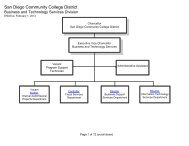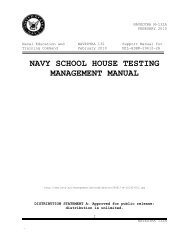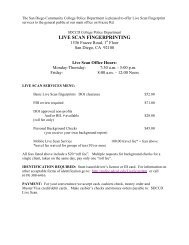NAVY SCHOOL MANAGEMENT MANUAL
NAVY SCHOOL MANAGEMENT MANUAL - AIM
NAVY SCHOOL MANAGEMENT MANUAL - AIM
- No tags were found...
You also want an ePaper? Increase the reach of your titles
YUMPU automatically turns print PDFs into web optimized ePapers that Google loves.
When a student is dropped from training or attrited from<br />
the Navy, the appropriate course supervisor should inform<br />
student control so the appropriate PEVT code can be used to<br />
support the TSC/DET SCO for input into CeTARS. The TSC/DET<br />
SCO is responsible for ensuring timely update to the<br />
disposition codes when final disposition becomes known.<br />
As with setbacks, drop from training and attrition is<br />
costly. Every effort will be made to maintain each as low<br />
as possible without lowering training standards.<br />
NETC (N7) will monitor drop from training and attrition<br />
trends, both academic and non-academic.<br />
Training managers and course supervisors are responsible<br />
for tracking and evaluating the causes for drop from<br />
training and attrition from the Navy.<br />
If through the monitoring process, the course supervisor<br />
determines that drop from training or attrition is a<br />
problem, a Training Analysis will be conducted by<br />
designated LS/LC personnel.<br />
Appendix B contains a list of elements that will help<br />
course supervisors evaluate the possible causes for drop<br />
from training/attrition/setbacks. This checklist may be<br />
used to pinpoint areas within the specific course that may<br />
cause the rates to increase. The training managers in the<br />
LSO and the training department, the CO, or NETC may also<br />
direct a training analysis.<br />
Total drop from training, attrition, and setback rates for<br />
a course will be analyzed and summarized as training<br />
quality indicators. Refer to Chapter 5, Section 4, for<br />
additional information.<br />
1.6. Time-to-Train (TTT)<br />
<br />
<br />
TTT is the principal method used to calculate actual<br />
student man-days expended in training. By understanding<br />
and applying the data from TTT, training managers are able<br />
to determine if excess man-days are occurring and for what<br />
reasons. Refer to NETCINST 1510.1 (series) for amplifying<br />
information.<br />
NETC (N7) sets threshold specifications for training under<br />
their cognizance. These specifications are used to<br />
determine if graduates are flowing through the pipeline<br />
within the specified period. Any man-days above the<br />
specification are considered excess. NETC monitors TTT<br />
data frequently and compares actual graduate man-days to<br />
3-7<br />
NAVEDTRA 135C
















